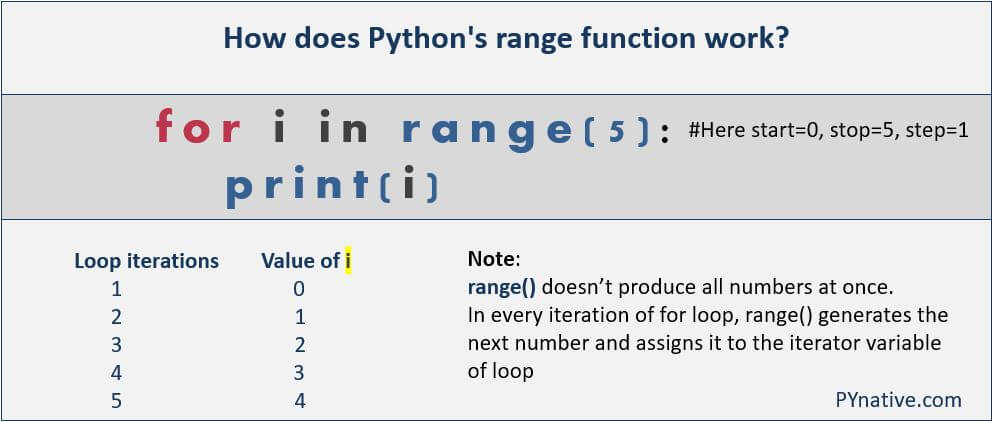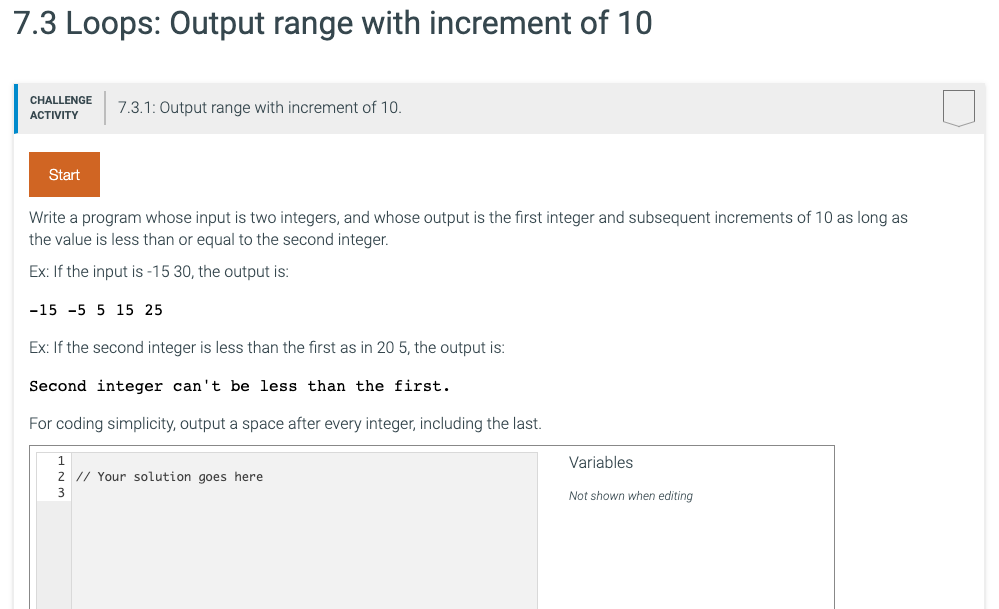Python For Loop Range Increment By 2
Using range will get the list of even numbers in the range given as input. It is widely used in for loops.
 Python Range Function Usage Explained In A Nutshell
Python Range Function Usage Explained In A Nutshell
Depending on how many arguments the user is passing to the function the user can decide where that series of numbers will begin and end as.

Python for loop range increment by 2. Besides that dont forget to subscribe to my email newsletter to receive updates on the newest articles. Hello When you know exactly how many times you want to loop through a block of code use the for loop instead of a while loop. Alternatively we could use the condensed increment operator syntax.
Let us see how to control the increment in for-loops in Python. The Python range constructor allows you to generate a sequence of integers by defining the start and the end point of the range. 1 2 3 4 5.
Incrementing Counter Variable by 2. In Python Using a for loop with range we can repeat an action a specific number of times. It steps through the items of lists tuples strings the keys of dictionaries and other iterables.
Please tell me about it in the comments in case you have any additional questions. Here is the syntax. For example if you want a sequence like this.
Range5 means it generates numbers from 0 to 4. It is a built-in function that returns a range object consists of a series of integer numbers which we can iterate using a for a loop. In this article we are using Python 3.
Typically the iterator section will say i. As we mentioned earlier the Python for loop is an iterator based for loop. As depicted by the flowchart the loop will continue to execute until the last item in the sequence is reached.
By default the first parameter is 0 and if you provide it only one parameter it takes it as the second parameter. Python for loop and range function. Python range function generates the immutable sequence of numbers starting from the given start integer to the stop integer.
Statement 1 is executed 100 time before the execution of the code block. In this R post you learned how to create for-loops with larger increments. The range function returns a list of consecutive integers.
Syntax of the For Loop. Heres a very short looping cheat sheet that might help you remember the preferred construct for each of these three looping scenarios. Go for this in-depth job-oriented Python Training in Hyderabad now.
Statement 3 is executed every time after the code block has been. X x 1. This time around I thought it would be fun to look at a few different ways to increment a number in Python.
Range 3102 Here the third argument considers the range from 3-10 while incrementing numbers by 2. The loop will continue to run as long as the conditions in the condition section are true. In Python 2 itertoolsizip is equivalent to the newer Python 3 zip function.
Python For Loop With Incremental Numbers Apart from specifying a start-value and end-value we can also specify an increment-value. For example range 5 will output will include the values 01234 and range 25 will give include the values 23 and 4. Range allows the user to generate a series of numbers within a given range.
Statement 2 defines the condition for executing the code block. The function has one two or three parameters where last two parameters are optional. As it turns out there two straightforward ways to increment a number in Python.
We can do this by using the range function. The usage of range with for loop in python will be as specified below. Range works differently in Python 2 and 3.
First we could use direct assignment. Range is typically used with the for loop to iterate over a sequence of numbers. For i in range 7.
However if you want to explicitly specify the increment you can write. Python For Loop Increment by 2 In the following example we will use range function to iterate over the elements of list using Python For Loop in steps of 2. By default the range increments numbers by 1.
1 3 5 7 9 then the increment-value in this case would be 2 as we are incrementing the next number by 2. Also note that zip in Python 2 returns a list but zip in Python 3 returns a lazy iterable. The body of the for loop like the body of the Python while loop is indented from the rest of the code in the program.
The R Programming Language. In the second iteration 1 is assigned to x and printpython is easy statement is executed. In the first iteration 0 is assigned to x and printpython is easy statement is executed.
The above example shows this odd behavior of the for loop because the for loop in Python is not a convention C style for loop ie for i0. Finally in the iterator section we increment the counter variable. In the third iteration 2 is assigned to x and printpython is easy statement is executed.
The parameters for range are start is 2 stop is 20 and step is 2 so the values will be incremented by 2 and will give even numbers till stop-2. This will increment our counter variable by 1 each time the loop iterates. This is a Python equivalent of the C-style for.
The Python for loop starts with the keyword for followed by an arbitrary variable name which will hold the values of the following sequence. Let us take a look at the Python for loop example for better understanding.
 The Python Script To Print Triangle Shape Of Number Follow Coding Python For More Such Python Related St Python Programming Data Scientist Data Analytics
The Python Script To Print Triangle Shape Of Number Follow Coding Python For More Such Python Related St Python Programming Data Scientist Data Analytics
 Free Python Course Understanding Loops
Free Python Course Understanding Loops
 The Python Range Function Python Beginners Series Arithmetic Progression Beginners Python Programming
The Python Range Function Python Beginners Series Arithmetic Progression Beginners Python Programming
 Python Range Function Explained With Examples
Python Range Function Explained With Examples
 Solved 7 3 Loops Output Range With Increment Of 10 Chall Chegg Com
Solved 7 3 Loops Output Range With Increment Of 10 Chall Chegg Com
 Python Range Function Linux Hint
Python Range Function Linux Hint
 How To Use Range In Python Youtube
How To Use Range In Python Youtube
Python Range Function H2kinfosys Blog
Post a Comment for "Python For Loop Range Increment By 2"